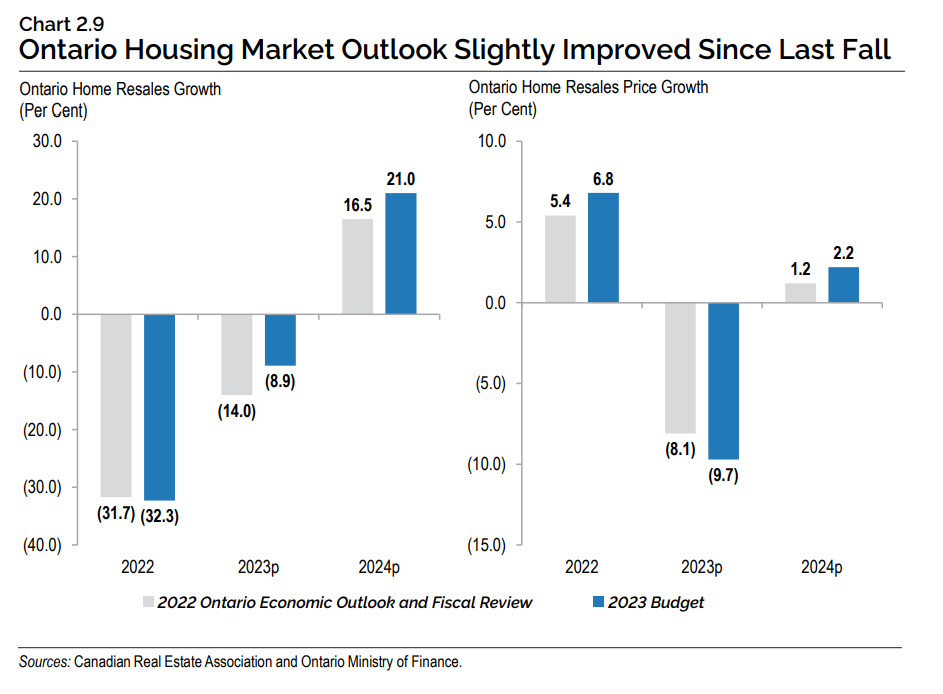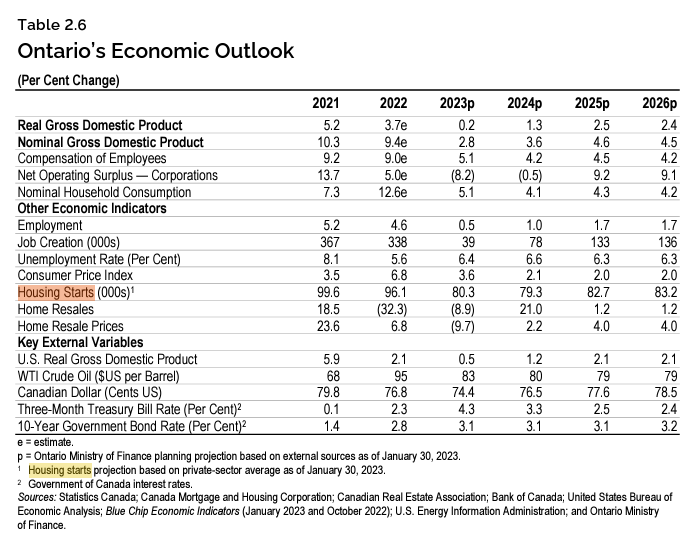Last week, Ontario’s Minister of Finance, Peter Bethlenfalvy, delivered the 2023 Provincial Budget entitled, Building a Strong Ontario. The Minister’s Budget speech is here.
In the months leading up to the budget OHBA actively participated in the pre-budget consultation process from late 2022 into 2023 and provided a comprehensive submission to government on key industry priorities that will enable our sector to build the housing choice and supply that Ontarians are counting on. This budget builds upon the provincial government’s latest Housing Supply Action Plan the More Homes Built Faster Act and advances important priorities called for by industry to support new home buyers.
Further to last week’s OHBA news release on the budget, attached you will find the full budget document and below you will find key highlights from the budget which members should be aware of,
Housing and Development
- The Ontario housing market activity continued to moderate through the end of 2022, as the market adjusted to rising interest rates.
- By January 2023, average home resale prices had declined by 21.3 per cent from their February 2022 peak, while the number of home resales was 43.4 per cent lower.
- For 2022, strong early momentum helped average home resale prices rise 6.8 per cent, following 23.6 per cent growth in 2021.
- The number of home resales was 32.3 per cent lower for 2022, following 18.5 per cent growth in 2021.
- Housing market activity is expected to begin to stabilize over the outlook period. The number of Ontario home resales is expected to decline by 8.9 per cent in 2023.
- Home resales are expected to rebound 21.0 per cent in 2024, before returning to levels more consistent with fundamental drivers of housing demand, such as population growth, in 2025 and 2026.
- Average home prices are expected to decline 9.7 per cent in 2023, before prices stabilize and rise 2.2 per cent in 2024 and further rebound in 2025 and 2026.
- The provincial government is continuing to call on the federal government to come to the table on potential Goods and Services Tax/Harmonized Sales Tax (GST/HST) relief, including rebates, exemptions, zero‐rating or deferrals, to support new housing and rental development in Ontario.
-
- This has the potential to be a highly impactful policy that OHBA called for in our pre-budget submission and we are pleased to see the province take the first steps to work with all levels of government to provide relief to new homebuyers and improve attainability.
- The provincial government has renewed its commitment to enabling the construction of Transit‐Oriented Communities
-
- Work is already underway to deliver on the Transit‐Oriented Communities at eight future stations along the new Ontario Line and Yonge North Subway Extension, creating over 73,000 new jobs and approximately 48,000 new residential units.
- The government is engaging with municipalities and building partners to explore new funding avenues to deliver cost‐efficient transit solutions for commuters.
- For example, the value created through the Transit‐Oriented Communities at the future Bridge and the High Tech stations will help build a new station at Royal Orchard along the Yonge North Subway Extension.
- The government is preparing for the selection of building partners for Transit‐Oriented Communities sites at future stations along the new subway lines, such as Corktown, Queen‐Spadina, King‐Bathurst and Exhibition stations.
- Building partners have been found for several future stations, with the government signing an agreement in April 2022 for a Transit‐Oriented Community at the future East Harbour Transit Hub.
- The planned 38‐acre East Harbour site will include the creation of a major employment centre, new residential and commercial space, community amenities and parkland, as well as affordable housing.
Skilled Trades & Apprenticeships
- Ontario requires about 72,000 additional construction workers by 2027 to meet its goal of reaching 1.5 million homes built by 2031.
- To help workers and job seekers, including apprentices, get the skills they need to take on new opportunities and advance in their careers, the government is enhancing the Skills Development Fund with an additional $75 million over the next three years. Since 2020, the government has invested close to $700 million in the Skills Development Fund to support those who face barriers in employment. To date, the government has delivered over 388 training projects to help more than 393,000 workers including carpenters, plumbers and health care workers take the next step in their careers within in‐demand industries.
-
- OHBA’s highly successful Job Ready program that helps introduce young people to rewarding careers in the skilled trades has been supported by the Skills Development Fund in the past and we will continue to push for this support in the future to help get more young people into rewarding skilled trade careers.
- Over 200 participants have taken part in the Job Ready Program since its inception.
- Over 50% of those have already moved onto higher paying positions.
- To help address the ongoing labour shortages and support economic growth, Ontario is investing an additional $25 million over three years to attract more skilled workers, including in‐demand professionals in the skilled trades, through the Ontario Immigrant Nominee Program. This program is focused on nominating applicants for permanent residency who have the skills and experience to support Ontario’s ambitious Plan to Build.
- The Ontario Immigrant Nominee Program (OINP) continues to grow over time, with Ontario’s allocation of nominations increasing from 6,500 in 2017 to over 18,000 by 2025. Ontario continues to work with the Government of Canada to attract more skilled newcomers to support economic growth and fill targeted labour market gaps across the province, particularly in the skilled trades.
Transportation and Infrastructure
- The province is investing $184.4 billion over the next decade and $20.6 billion in 2023–24 in capital infrastructure.
- Key highlights in the capital plan include $27.9 billion over 10 years to support the planning and/or construction of highway expansion and rehabilitation projects across the province. New highway infrastructure is crucial to supporting new housing supply in communities across Ontario. Key projects include,
-
- Highway 413, a new 400‐series highway and transportation corridor across Halton, Peel and York regions that will bring relief to the most congested corridor in North America and save drivers up to 30 minutes each way on their commute.
- Bradford Bypass, a new four‐lane freeway connecting Highway 400 in Simcoe County and Highway 404 in York Region, saving motorists and commercial truck drivers up to approximately 35 minutes in travel time compared to using existing routes along local roads.
- $70.5 billion over 10 years for public transit with a variety of projects underway, including:
- Transforming the GO Transit rail network into a modern, reliable and fully integrated rapid transit network. GO Expansion will improve access and convenience across the Greater Golden Horseshoe by steadily increasing service with faster trains, more stations and better connections.
- Making investments to expand GO Transit rail service to Bowmanville and the Niagara Region.
- Awarding two major contracts and releasing two Requests for Qualifications (RFQs) for the Ontario Line, which will provide rapid transit between Exhibition/Ontario Place and the Ontario Science Centre and connect more than 40 other transit routes, including GO train lines, subway and streetcar lines and the Eglinton Crosstown.
- Beginning tunnelling for the three‐stop Scarborough Subway Extension from Kennedy Station to Sheppard Avenue and McCowan Road and awarding the contract for design and construction of new underground stations with bus terminals.
- Continuing tunnelling on the Eglinton Crosstown West Extension.
- Purchasing three new trainsets to restore the Northlander passenger rail service to provide a safe and reliable transportation option for Northern communities.
- Making progress on delivering fast, reliable transit, including the Hazel McCallion Line and Finch West Light Rail Transit projects.


